Cave research in India
Cave research, encompassing the study of speleology and biospeleology, is still in its infancy in India. Although there are thousands of caves in India, research expeditions occur in few states. The Siju Cave of state Meghalaya is the first limelighted natural cave from India. Several studies were carried out in this cave in the early 20th century. The Kotumsar Cave of Central India is one of the most explored caves of India,[1] and biologists have classified many types of cavernicoles, i.e. trogloxenes, troglophiles and troglobites, from this cave.[2]

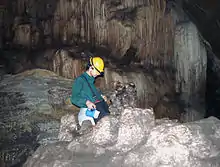
The Indian institution mainly engaged in this particular field of research and conversational issues of Indian caves is the Raipur-based National Cave Research and Protection Organisation[3] (founded and headed by Dr Jayant Biswas).[4] The other notable organisation is Meghalaya Adventurer Association (founded and managed by Brian Dermot Kharpran Daly)[5] which mainly involved in the caving and cave explorations of the existing caves of the state Meghalaya.[6]
Caving regions
Andhra Pradesh
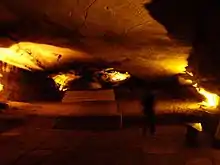
- Akka Mahadevi Cavesetc.
- Belum Caves, length: 3,229 m (10,594 ft), Belum Village in Kolimigundla Mandal of Kurnool District, 15.102346°N 78.111541°E
- Borra Caves, length: 625 m (2,051 ft)
- Guthikonda Caves,
- Guntupalli Caves,
- Moghalrajapuram Caves,
- Undavalli Caves
- Yaganti Caves,
Chhattisgarh
- Aranyak Cave of Kanger Ghati National Park
- Dandak Cave of Kanger Ghati National Park, length: 362 m (1,188 ft)
- Kailash Caves of Kanger Ghati National Park, length: 253 m (830 ft)
- Devgiri Cave of Kanger Ghati National Park
- Jhumar Cave of Pedawada village Kanger Ghati National Park
- Jogi Cave of Gadiya Mountain Kanker, length: 50 m (160 ft)
- Kailash Cave of Jashpur district, Chhattisgarh
- Kanak Cave of Kanger Ghati National Park (yet unexplored)
- Kapatdwar Cave of Tokapal, Bastar, length: 30 m (98 ft)
- Khuriarani Cave of Bagicha Village Jashpur district, Chhattisgarh, length: 27 m (89 ft)
- Kotumsar Cave of Kanger Ghati National Park, length: 660 m (2,170 ft)
- Mandhip Khol, Gandai, Rajanandgaon length: 430 m (1,410 ft)
- Mendhkamaari Cave of Kanger Ghati National Park
- Rani Cave of Tokapal, Bastar, length: 50 m (160 ft)
- Shakal Narayan Cave of Bhopalpatnam, Bijapur district, Chhattisgarh
- Shankanpalli Caves of Bijapur district, Chhattisgarh
- Sheet Cave of Kanger Ghati National Park, length: 25 m (82 ft)
- Singhanpur cave, Raigarh (yet unexplored)
- Sondayi cave, Kanker, length: 40 m (130 ft)
- Tular Cave of Narayanpur District, Chhattisgarh
- Usur Cave of Usur Block, Bijapur district, Chhattisgarh
Haryana
None of these have been studied scientifically yet.
- Dhosi Hill cave in Aravalli Mountain Range, Narnaul, Mahendragarh district
- Tosham Hill cave in Aravalli Mountain Range, Hisar-Tosham road, Bhiwani district
- Nar Narayan Cave in Sivalik Hills range, Yamuna Nagar district
Madhya Pradesh
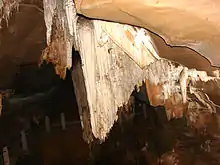
- Bagh Caves of Dhar district
- Bhimbetka cave of Raisen District
- Jana Mana Cave of Kanha National Park
- New cave in Raisen District, few ancient caves of Madhya Pradesh are well known. Few more caves have also been recently limelighted.
Meghalaya

The Indian state, Meghalaya is famous for its many caves, which attract tourists not only from India but abroad too. A few of the caves in this region have been listed amongst the longest and deepest in the world.
Khasi hills
- Krem Dam, length: 1,297 m (4,255 ft)
- Krem Mawmluh (4th longest in the Indian sub continent)
- Krem Mawsynram
- Krem Phyllut, length: 1,003 m (3,291 ft)
- Krem Soh Shympi (Mawlong, East Khasi Hills), length: 760 m (2,490 ft)
- Mawsmai Cave (show cave exclusively for tourists)
Jaintia hills
- Ka Krem Pubon Rupasor or The Rupasor Cave
- Krem Kotsati, length: 3,650 m (11,980 ft)
- Krem Lashinng, length: 2,650 m (8,690 ft)
- Krem Liat Prah, length: approx 31 km (Longest in the Indian Subcontinent)
- Krem Sweep, length: 970 m (3,180 ft)
- Krem Um-Lawan, length: 6,381 m (20,935 ft)
- Krem Umshangktat, length: 955 m (3,133 ft)
Garo Hills
- Bok Bak Dobhakol, length: 1,051 m (3,448 ft)
- Dobhakol Chibe Nala, length: 1,978 m (6,490 ft)
- Siju-Dobkhakol, length: 4,772 m (15,656 ft)
- Tetengkol-Balwakol, length: 5,334 m (17,500 ft)
Most of the caves of these areas were either discovered or surveyed by the Europeans (especially by German, British and Italian cavers). Herbert Daniel Gebauer, Simon Brooks, Thomas Arbenz and Rosario Ruggieri are the most prominent name among them. Brian Khapran-Daly of Meghalaya Adventure association have expedite most of the caves of Meghalaya (stated above). In addition to these, the cavers' associations of Meghalaya have always been found to be active in cave discoveries of that plateau.
Uttarakhand
- Gauri Udiyar Cave in Bageshwar district
- Khatling Cave in Tehri Garhwal district
- Lakhudiyar Caves in Almora district
- Pandkholi Cave in Ranikhet district
- Patal Bhuvaneshwar Cave in Pithoragarh district
- Rai Cave in Pithoragarh district
- Robber's Cave (Guchhupani) in Dehradun district
- Shivam Cave in Pithoragarh district
- Sukhram Cave in Bageshwar district
- Vashishtha Cave in Rishikesh
and many more scientifically unexplored caves
Cultural importance
.jpg.webp)
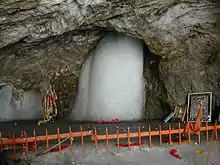
In India, many caves are popular tourist sites. The caves of Ajanta, Udaygiri, Barabar, Undavalli, Pandavleni, Ellora are famous for archaeological finds and ancient architectural value.
Religious importance
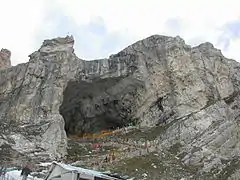
The stalagmite formations present in most natural limestone caves resemble Shiva Linga, a representation of Hindu God Shiva, due to which some of the caves in India are considered of religious import. In addition, several universally known caves related to Buddhism is also exist in India. The same attraction leads local people to visit small caves as it draws tourists to large show caves. In India, Amarnath Temple caves, Vaishno Devi Mandir, Badami Cave Temples, Hulimavu Shiva cave temple, Mahakali Caves, Mandapeshwar Caves, Pandavleni Caves are some of the caves with religious importance.
Current research
Jayant Biswas and his contemporaries continue to research the biospeleology of Meghalaya, Chhattisgarh, Uttarakhand and Western Ghats to establish India amongst other notable countries on the cave map of the world.
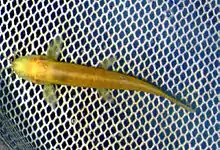
Research is also taking place on Indian cave stalagmites, to estimate the past monsoon climate. Dr Ashish Sinha of California State University is taking major steps to understand the past pattern of Indian monsoons via cave research. In addition, Prof. Rengaswamy Ramesh; Dr. M. G. Yadava of Physical Research Laboratory, Ahmedabad; Prof. Bahadur Kotlia of The Durham, Kumaun University Nainital; Dr. Syed Masood Ahmad & Mahjoor A. Lone, CSIR - National Geophysical Research Institute (NGRI), Hyderabad; and Dr. Jayant Biswas, National Cave Research and Protection Organisation, India, also initiated some research in this direction.
Besides Dr. Biswas, Prof. G. Marimuthu of Madurai Kamaraj University, Madurai (Chiropterology - study of Bats); Prof. Y. Ranga Reddy Acharya Nagarjuna University (micro Crustacean: Taxonomy); Dr. Shabuddin Shaik Acharya Nagarjuna University (Crustacean Taxonomist) Dr. Daniel Harries of Edinburgh (Cave Biodiversity) and Dr. Adora Thabah of Bristol University (Chiropterology - study of Bats); Prof. R. K. Pradhan Pandit Ravishankar Shukla University of Raipur (Chronobiology); Prof. Ramanathan Baskar Guru Jambheshwar University of Science and Technology, Hisar, Haryana (Cave Geomicrobiology) are some of the known researchers who have tried to shed some light on the Biospeleology (study of organisms that live in caves) of Indian caves.
Conservation
Unscientific quarrying of limestone led to the collapse of the Mawmluh cave of Meghalaya,[7] and the caves of Jantia Hills are also in danger due to excessive quarrying of coal.[8] Various caves in Central India serving as major religious spots are also either under threat conditions or somehow polluting the ambient environment.[9]
The 'National Cave Research and Protection Organisation, India' has been formed to help protect the caves of India.[10] This organization has already urged the Indian government to frame a proper Cave Protection Act.[11] In addition, members of the Meghalaya Adventures Association (principally, Brian Kharpan Dally) work to protect the natural caves of Meghalaya.
See also
References
- Kotumsar Cave is biologically best known cave in India The Hitavada
- Biswas, Jayant (2010). "Kotumsar Cave biodiversity: a review of cavernicoles and their troglobiotic traits". Biodiversity and Conservation. 19: 275–289. doi:10.1007/s10531-009-9710-7.
- "National Cave Research and Protection Organisation". caves.res.in.
- "The Tribune, Chandigarh, India - Jobs & Careers". tribuneindia.com.
- "A caver's sojourn". The Hindu. Retrieved 9 May 2016.
- "Caving". Adventure Nation. Archived from the original on 2015-07-04.
- Limestone mining causes part of India’s seventh longest cave to collapse The Telegraph Archived 2009-08-08 at the Wayback Machine
- Coal mining threatens Meghalaya caves Down to Earth
- Govt urged to conserve caves in C’garh. The Hitavada Archived 2017-08-03 at the Wayback Machine
- "Ramesh petitioned against Lafarge plant in Meghalaya". Times of India. 16 November 2010. Retrieved 2010-11-19.
- Caving in. Down to Earth
External links
- Biswas Jayant 2010 Kotumsar Cave biodiversity: a review of cavernicoles and their troglobiotic traits
- Biswas Jayant 2009 The biodiversity of Krem Mawkhyrdop of Meghalaya, India, on the verge of extinction
- Ashish Sinha, Gayatri Kathayat, Hai Cheng, Sebastian F. M. Breitenbach, Max Berkelhammer, Manfred Mudelsee, Jayant Biswas & R. L. Edwards 2015 Trends and oscillations in the Indian summer monsoon rainfall over the last two millennia
- Harries, D.B., Ware, F.J., Fischer, C.W., Biswas, J. and Khapran-Daly, B.D. 2008 A Review of the Biospeleology of Meghalaya, India
- Sinha Ashish, Berkelhammer Max , Stott Lowell , Mudelsee Manfred, Cheng Hai and Biswas Jayant 2011 The leading mode of Indian Summer Monsoon precipitation variability during the last millennium
- Harries, D.B., Ware, F.J., Fischer, C.W., Biswas, J. and Khapran-Daly, B.D. 2008 A Review of the Biospeleology of Meghalaya, India
- Ruggieri Rosario, Biswas Jayant 2011 The Karst Mandhip Khol-python cave complex in the lenticular limestone intercalations of the metamorphic Chhatrela formation (Chhattisgarh, India)
- Rajput Yogita and Biswas Jayant 2012 Subterranean Depth Dependent Protein Constitutions of the Micrococcus sp., Isolated from the Kotumsar Cave, India
- Baskar Sushmitha and Baskar Ramanathan 2014 A Summary of Some Microbes Identified from Different Indian Caves and Their Possible Role in Mineral Formations
- Biswas Jayant 2014 Occurrence and Distribution of Cave Dwelling Frogs of Peninsular India
- Mahjoor Ahmad Lone et al., 2014 Speleothem based 1000-year high resolution record of Indian monsoon variability during the last deglaciation
External links
| Wikimedia Commons has media related to Caves in India. |
- cave-biology.org Cave biology (biospeleology) in India
- caves.res.in National Cave Research and Protection Organization, India
- Ambient Science Scientific Peer Reviewed Journal by Nat. Cave Res. & Prot. Org., India
- questchhattisgarh.in Some Caves of Chhattisgarh